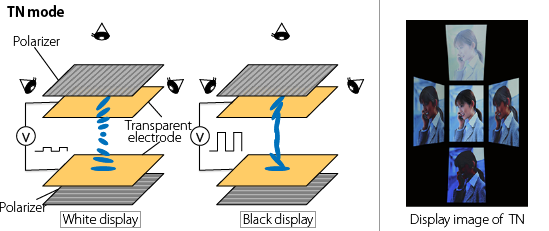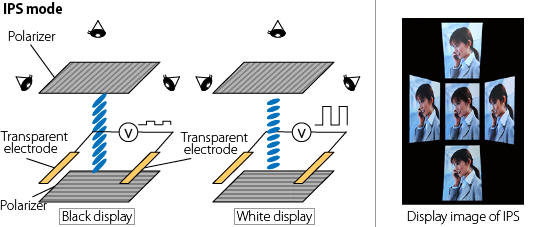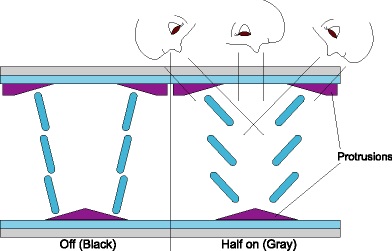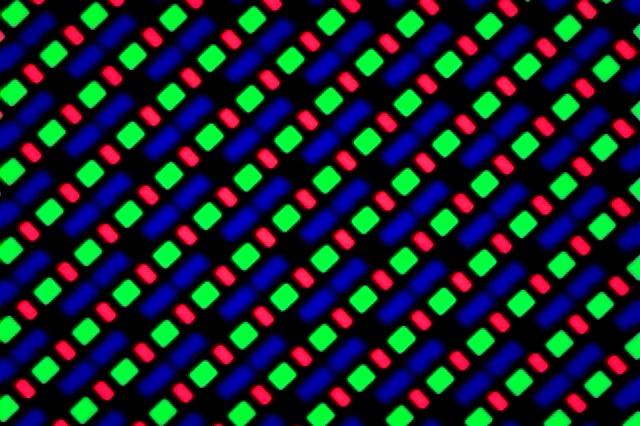AT 101: Understanding Laptop Displays & How We Test Them
by Brett Howse on July 10, 2018 8:00 AM ESTPanel Technology - TN, IPS, VA, & OLED
Liquid crystal displays more or less fall into three categories based on their manufacturer and the driving force behind the liquid crystal. All have their own strengths and weaknesses. Twisted nematic, or TN as it’s often called, is an older display technology. Later, In-Plane Switching, or IPS displays, were developed to combat some of the problems with TN, and a third major technology is the Vertical Aligned, or VA panel.
All LCDs are pretty much built the same, with a backlight, two polarizers, the liquid crystal, and the thin-film transistor which provides the current to the individual pixels. The major difference between the three display types is how the liquid crystal is used to block the backlight for each subpixel.
Generally, laptop displays refresh the image sixty times per second, or at 60 Hertz. Some gaming laptops offer refresh rates at 144 Hz or more, which provide a smoother experience, and both AMD and NVIDIA support variable refresh rates as well. The maximum refresh rate is impacted by the design of the LCD, and the various designs all have different limits and response times.
Twisted Nematic
Twisted nematic, or TN, is the earliest LCD design that’s still used in laptop displays. As the name suggests, the liquid crystal actually twists to allow light through. The design is very simple, with only a single transistor required to drive the process, and therefore it’s the least expensive display to manufacture as well. In addition to it being the lowest cost, it also can operate very quickly, so the TN display is still the panel of choice for many gamers because the panels can hit the high refresh rates like 144 Hz.

Image Source: Japan Display Inc.
While cost and speed are definite advantages of TN, they suffer from quite severe off-angle color shift and are really only usable when viewed directly. Large TN panels can exhibit the color shift even when viewed directly, because of the increasing angle of viewing (relative to the user) as the panel gets further from the center. Even when viewed directly, TN panels offer poor color accuracy as well. Due to these limitations, TN displays have fallen out of favor for most laptops, although they are still regrettably found in some budget devices, and gaming laptops where the higher refresh rate is of more importance than color reproduction.
In-Plane Switching
In-plane switching, or IPS, was developed to provide solutions to the off-angle viewing issues that plague TN displays. The liquid crystal rotates horizontally rather than twisting like a spring in TN, allowing more light through the further it’s rotated, which in turn varies with the amount of voltage applied. This process requires two transistors per subpixel though, which drives up the manufacturing cost. IPS displays are not as quick to operate as a TN one would be either, so driving them to very high refresh rates is difficult. But, this design does offer excellent off-angle viewing, as well as very accurate color reproduction.

Image Source: Japan Display Inc.
And while IPS is a significant step up in quality over TN, it does have some limitations of its own. In particular, it can’t produce the highest contrast ratios, especially compared to Vertical Aligned panels that we’ll look at next. But IPS displays offer the widest viewing angle of any display technology, and keep their color accuracy intact even when viewed at an angle. This makes them ideal for laptops and tablets, and pretty much all quality laptops utilize IPS displays at this point, although this really only started in earnest in the last several years.
Although IPS is the generic class, several manufacturers have created their own version of IPS, such as Samsung’s Plane to Line Switching (PLS) or AU Optronics with their Advanced Hyper-Viewing Angle (AHVA) technology, which by the acronym sounds like it is a VA panel, but it’s actually an IPS design.
Vertical Alignment
The final display LCD display technology that is prevalent in the industry is the vertical alignment, or VA, panel. VA aligns the liquid crystal vertically when no voltage is applied, and with voltage, the crystals shift to the horizontal plane. This mechanism does have some drawbacks to viewing angles, but to counteract this, most VA panels use multi-domain vertical alignment (MVA) with the crystals rotating in different directions.

Image Source: Tom's Hardware Guide
The biggest advantage of VA displays is their contrast ratio capabilities, and modern VA panels can achieve 3000:1 or more contrast. With MVA technology the off-angle viewing is also much better than TN displays, although not as good as IPS displays, and where an IPS display can achieve 178° viewing angles on both the horizontal and vertical planes, a VA panel is going to be around 160° or so depending on the exact type of panel.
The main disadvantage of VA panels is the very slow response time, especially in the gray-to-gray.
VA panels can be found in some computer monitors, but most laptops utilize IPS because the strengths are more suitable to a portable device. VA is still widely used in televisions though, since you generally don’t view them at a very oblique angle, and the increased contrast ratio provides better black levels for movies.
Organic Light Emitting Diode
The final display technology that is available in laptops is organic light emitting diode, or OLED. Unlike all the LCD displays, OLED doesn’t require a backlight because the individual subpixels emit light. Because of this, OLED displays offer practically infinite contrast ratio, since the brightness of each subpixel can be varied on a subpixel-by-subpixel basis, and subpixels can be turned off completely.
OLED displays have been used quite a bit in smartphones, and you can even buy OLED televisions, but the technology has not been utilized very much in the PC space.
Although OLED displays offer a lot of advantages over LCD displays, OLED with an RGB (Red Green Blue) matrix of subpixels (aka RGB OLED) is quite expensive to build, especially on a larger panel. The amazing contrast and accurate color reproduction is a benefit, but the cost can be prohibitive. OLED also doesn’t use any power to display a black screen, but to get high brightness levels on a large panel showing a white image can use substantially more energy than a comparable LCD.

Microscopic view of the ThinkPad X1 Yoga OLED Display subpixel arrangement
Besides price, the other notable drawback to OLED is that the nature of the technology can limit the longevity of the display. As the subpixels are used to create light in either red, green, or blue, the subpixels themselves age and will dim over time. The different colors also age at different rates – with blue being the fastest to go – and to compensate, the subpixels may not be arranged in a true RGB pattern which can reduce the effective resolution of the device. Because of the different rates, there’s also a chance of burn-in if a static image is left on the display for a long period of time, a problem which in turn can be mitigated, though not entirely.
Currently televisions that use OLED are almost exclusively built on a different technology than what you’d see in smartphones and laptops. Right now, LG owns the OLED TV market and produces panels for everyone else using WOLED, which is a white OLED subpixel that is paired with color filters to convert said subpixels to red, green, or blue subpixels. This allows the panels to be manufactured for a cost that people can actually afford, and partially mitigates burn-in since all subpixels have a similar life-expectancy curve. However WOLED subpixels will still age faster or slower depending on how heavily they're used, so burn-in can still be an issue.
Samsung is reportedly looking into something similar, but will use a blue OLED as the base and quantum dots as the filter/converter. But neither of these technologies are used in laptops at the moment, so when you see an OLED TV for several thousand, and wonder why an OLED PC monitor is double the cost for a quarter the size, just know that all things are not created equally.
OLED also can have an issue with ghosting as well, although inserting black frames in between images can reduce that effect.
Due to the cost, high power usage, and aging issues, OLED is currently not ideal for use in laptops, and although it can be stunning to see in a laptop, it does have its drawbacks.










49 Comments
View All Comments
linuxgeex - Thursday, July 12, 2018 - link
"Driving the extra pixels with the GPU and other components is a tiny difference. That's a common misconception you've stumbled upon."Going from 1920x1080 to 3840x2160 is 4x the rendering cost, minimum (recognise that given more than 2 layers to composite you can easily exceed the CPU's L3 cache size with a 4k display), and that is 4x the amount of time that the CPU and all related subsystems can't drop to C7 sleep.
It's not a tiny difference at all. If it was negligible then why is the OS trying to use PSR (Panel Self Refresh) and FBC (FrameBuffer Compression) to reduce the IO channel and RAM access overheads, while those costs are negligible compared to keeping the CPU and GPU spinning with rasterizing and compositing.
What's keeping your OS and apps compositing constantly? Your browser which now does full-page 60hz updates of every pixel, changed or not, so the OS can't send only the damaged pixels to the display device as in earlier versions. Why? Because modern machines are fast enough and it's a "small difference" but keeps the render pathways hot in the caches so less frames are dropped. Welcome to 2018, when your battery life got slaughtered and people haven't quite clued in yet.
erple2 - Sunday, July 22, 2018 - link
PSR and FBC tasks are tackling the 20% case, though, namely the parts at idle where 80% of the power consumed is just directly from keeping the backlight bright enough that the LCD can be seen. Note also that PSR and FBC doesn't make that much of a difference in battery life overall. I've seen up to about 10% in some cases. And that's consistent with doubling the GPU rendering pipeline efficiency _at idle_ for the entire display pipeline. Doubling the efficiency of 20% of your overall budget decreases power consumption by around 10%.Note that much of the compositing engine is offloaded (in modern GPUs) from the heavyweight parts of the 3D rendering pipeline, so those costs aren't that high in comparison. It's not like you're keeping all 2048 stream processors (or however many equivalent GPU processors) active 60 times a second. That was the first "revolution" in GPU efficiency gains a while back - you didn't need to keep your entire GPU rendering silicon active all the time if they weren't being used.
linuxgeex - Wednesday, July 11, 2018 - link
"Less expensive displays may even reduce this more to 6-bit with Frame Rate Control (FRC) which uses the dithering of adjacent pixels to simulate the full 8-bit levels."No. FRC uses Temporal dithering. It shows the pixel brighter or darker across multiple frames which average out to the intended intensity. On displays with poor response times this actually works out quite nicely. On TN displays, you can actually see the patterns flickering when you are close to a large display and cast your gaze around the display. Particularly in your peripheral vision which is more responsive to high-speed motion changes.
VA - You mentioned MVA, which is one type of PVA arrangement. PVA is Patterned Vertical Alignment, where not all of the VA pixels/subpixels are aligned in the same plane. Almost all VA displays are PVA. PVA allows to directly trade display brightness for wider viewing angles, and to choose in which direction those tradeoffs will be made. For example a PVA television will trade off mostly in the horizontal direction because that allows people to sit in various places around the room and still see the display well. They don't need to increase the vertical viewing angle so that the roof has a good view of the tv. ;-) But for a laptop just the opposite is true. You want to still see the display well when you stop slouching or stand up, but you don't really care if the people to your sides can see your display well. In fact, people purchase privacy guard overlays that reduce the side viewing angles intentionally.
Brett Howse - Wednesday, July 11, 2018 - link
Excellent info thanks!linuxgeex - Thursday, July 12, 2018 - link
The author was obviously in a hurry, saw the word "dithering", and jumped to the conclusion that it was spatial error distribution dithering as is commonly used in static images to create an appearance of a larger palette. ie GIFs, printers. But for video there's a 3rd dimension to perform dithering in which doesn't trade off resolution or cause edge flickering artefacts, so of course they're going to use FRC (Frame Rate Control which is basically a form of PWM) instead of spatial dithering.linuxgeex - Thursday, July 12, 2018 - link
Oh Brett, lol that's you. ;-)UtilityMax - Friday, July 13, 2018 - link
WTF, you guys still test laptop displays at the time when more than half of personal computing has already moved onto mobile devices, like phones or tables, which you no longer review? Mmmokay.linuxgeex - Friday, July 13, 2018 - link
Actually they have reviewed new phones within the last 30 days... Mmmokay.Zan Lynx - Saturday, July 14, 2018 - link
A tablet is just a gimped laptop without a keyboard.madskills42001 - Tuesday, July 17, 2018 - link
Given that contrast is the most important factor in subjective image quality tests, why is more discussion not given to it in this article?